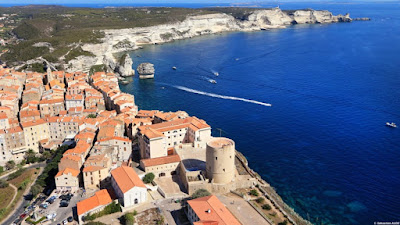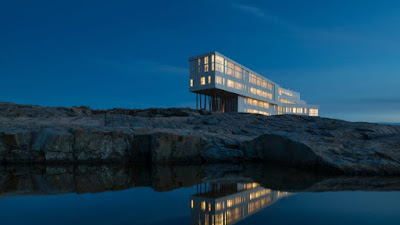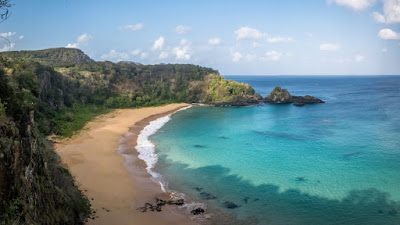Bonifacio: City of Cliffs is France's best-kept secret
An undiscovered beach town in Mediterranean Europe? Well, almost.
Perched high up a white limestone cliff on the southern coast of Corsica lies the medieval town of Bonifacio.
Known as the "Mediterranean's Sentinel," or simply, the "Citadel of Cliffs," it's arguably the best-kept secret in France. It's untroubled by summer crowds despite being in possession of beautiful cobblestone alleyways and a shoreline of sparkling waters.
Bonifacio is on the southern coast of Corsica, separated from the Italian island of Sardinia by the 11-kilometer-long Strait of Bonifacio, which is named after the town.
The two islands were once joined, but volcanic activity tore them apart, leaving huge shards of granite rock in the turquoise waters.
The sea floor here is now dotted with wrecks of pirate ships and ancient vessels which crashed against the many crags, and has become a mecca for divers.
"During the harshest winds, fishermen boats can't get out of the harbor because of the high waves and strong currents," says local wood artisan Pietro Borsu while surveying the mouth of Bonifacio.
But the occasionally unforgiving sea has played a huge part in keeping this southernmost tip of Corsica so pristine.
"The crags, carved by the millinery joint action of sea and strong winds, are a natural fortress that has kept the village safe across centuries," adds Borsu proudly.
Protected fortress town
Bunifaziu, as locals call Corsica's oldest town, has much to protect.
Forget mass tourism, packed beaches and English-speaking travelers, this secluded town features an ancient citadel, narrow streets, colorful houses and fiery separatist locals, who speak in a unusual dialect comprised of Italian and French, and dream of independence.
With its myriad of monasteries, chapels, prehistoric sites and Roman cisterns, you'd be forgiven for thinking you were in Italy rather than France.
L'Arinella, a secluded beach, reachable via a panoramic coastal hiking route, is one of the town's highlights.
However, locals prefer to go to the multi-layered cliffs to sunbathe in caves or skinny dip in hidden coves, with the view of Sardinia's La Maddalena archipelago out in the distance.
Poetic history
Founded at around 830 A.D., Bonifacio is Corsica's oldest town and is believed to have been referenced in one of the most ancient -- and popular -- poems ever written.
According to legend, it's the land in Homer's "Odyssey" where Greek hero Odysseus runs into a local tribe called the Laestrygonians, who are described as giant cannibals. Luckily, the cunning warrior manages to escape before being eaten.
Nowadays Bonifaciens have decidedly different dietary preferences.
Honey-roasted baby piglet covered, clams stuffed with grated sheep cheese and aubergines cooked the Bonifacio way are among the local specialties.
Brocciu, fresh ricotta served with platters of strong-scented salami and hams that compose local "terroir" products, is also a favorite, as is Figatellu, a pork and liver sausage.
Restaurants of note include U Castillé (7 Rue Simon Varsi; +33 4 95 73 04 99), offering great views of the cliffs, Ciccio (Rue Saint-Jean Baptiste; +33 6 16 98 81 68), which is enclosed by old stone walls and Stella d'Oro (7 Rue Doria; +33 4 95 73 03 63), featuring an old olive mill.
Locals tend to spend their evenings in cafés and pubs, with Café de la Poste (6 Rue Fred Scamaroni; +33 4 95 73 04 58) in the main piazza a top draw as well as La Caravelle (Quai Comparetti; +33 4 95 73 03 18), which is also a hotel and fish tavern, overlooking the town's picturesque port.
Legendary sites
Many of the town's main gems lie beneath the surface, but you have to work hard to reach them.
The Staircase of King Aragon Alfonso V features 187 steep steps, carved inside the flanks of the cliff, that descend to the sea.
With an inclination of 45 degrees, dizziness and painful thighs are almost guaranteed.
Legend has it the staircase was built by the King of Aragon's guards in one night during the failed siege of Bonifacio in 1420, though it's most likely to have been constructed by residents to collect fresh water from a spring.
This is a killer path, especially the climb back, so it's best to avoid tackling it throughout the hottest hours of the day.
Once at the bottom, you can refresh with a nice dive into the turquoise waters.
Then there's the chemin de ronde, which runs inside the fortified walls surrounding the citadel and is a great place to escape the scorching sun.
The walkway leads to the sailors' graveyard (Cimetiere Marin), with its stunning views of the strait.
From the tiny chapel of St. Roch, a narrow stair descends to the equally tiny pebble beach of Sutta Rocca facing the Grain de Sable, huge lump of fallen rock face which local youngsters love to dive from.
It's also a great snorkeling spot thanks to the blue and red starfish swimming a few feet from the shore.



